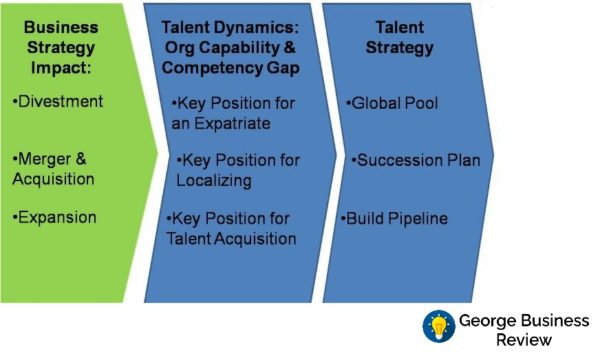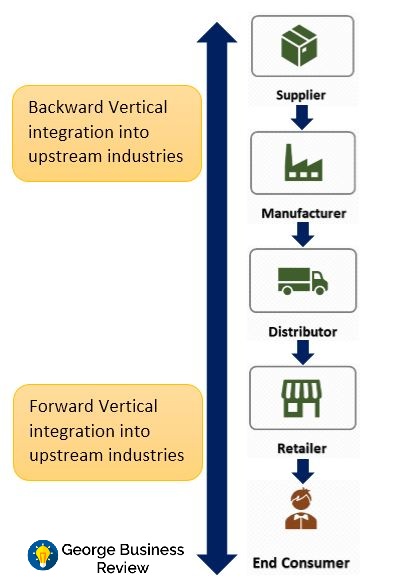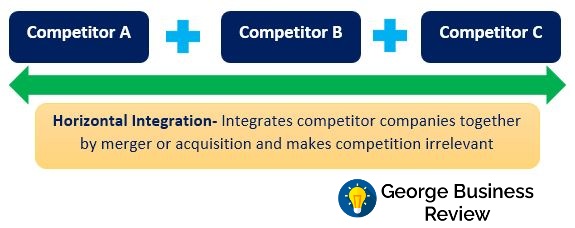Introduction
Strategic human resource management or SHRM is the procedure by which human resource department interrelates with the other departments and try to realize the goals of other departments, furthermore it generates strategies that will help to achieve the goals of the company (Lengnick-Hall, Beck, and Lengnick-Hall, 2011). Business strategy refers to the decisions and movements executed by an organization to achieve the business goals. It also makes remarkable place in the targeted market (Daley, 2012). In this first part of the paper, the relationship between business strategy and SHRM with the explanation of vertical alignment and horizontal integration has been critically evaluated. Strategic management of human resources- Best fit, Best practice and Resource based View has been also critically evaluated.
Relation between Business Strategy and Human Resource Strategy
Business strategy is the plan which is executed by an organization for its long term success (Storey, 2014). HR strategy indicates the plan that is made to utilize the HR power and talent to achieve the goals of an organization. Business strategy is made first then HR makes their own strategy by bearing in mind the business strategy. For example, if an organization has target of increasing sales, the HR will hire eligible sales executive to increases the sales and fulfil the sales target.

Business strategy and Human Resource Management are related to each other on the basis of many perspectives. The connection of business strategy and human resource management makes sure that the properties and investment will be utilized properly to fulfil the target of an organization (Mello, 2014). SHRM assists a company to improve and instruct the workers for the betterment of the company. In addition business strategy is a long term plan to utilize the strengths of a company in order to achieve remarkable place in the market the company want and compete successfully with competitors.
Business strategy and strategic human resource both are beneficial for an organization and influence an organization positively. A business strategy is the long term plan that helps an organization to fulfil their aim and human resource strategy is a portion of the business strategy. Business strategy emphasizes on implementing the long term plan that will help the organization to fulfil their target therefore an organization can ensure their progress by making business strategy and human resource strategy emphasizes on enhancing the capabilities of workers according to an organization’s requirement. As a result, employees get the chance to enhance their skills and become able to work effectively to implement the business strategy (Chen, and Huang, 2009). For example, if business strategy aims to be more productive than before by reducing manufacture cost and human resource strategy implement the aim by maximizing the utilization of HR’s power and talent (Wright, and McMahan, 2011).
You might also be interested in: Definition of human resource management Tips to make a workplace effective How to implement High Performance Work? How HRM contributes to high performance working? The nature of employee relations
Vertical integration and Horizontal integration Strategy
Vertical Integration strategy
Vertical Alignment or integration is the strategy in which a business organisation owns all the sages of both backward and horizontal industries in which all levels of the supply chain are controlled by the business.

In such a business model, stakeholders are concerned about the target of their organization and their contribution toward achieving the goals. In vertically aligned organization, every level of employees know the business strategy and works to contribute to make the business strategy tangible. Vertical alignment ensures that work is going on in every stage of every department that ensures the implementation of the business strategy.
Advantages of vertical alignment are: It informs everyone about their responsibilities and it encourages them to work better, raise the sense of co-operation and coordination among departments. Such factors of advantages help a company implement the business strategies. Disadvantage of the strategy is it needs strong power leadership of top level to control the organizational structure. What is more important of this business strategy is that vertical integration helps the business to own the whole value chain by which the company can controls all the stages of the business. Therefore, this strategy helps the business to have full control across the supply chain.
Horizontal Integration Strategy
Horizontal integration is a business strategy which entails that different competitors in the same industry are merged together and thus they make one single company- making the sense of competition irrelevant. For example, if Apple, Samsung, Oppo, ZTE, Huawei merge together and manufacture smartphone, this arrangement can be called horizontal integration because the competitors working in the same level of supply chain have merged together. The concept has been presented below.

An important benefit of horizontal strategy is that it leverages high level of capability of a company in all aspects because the company becomes strong from financial and innovation perspectives. Another advantage is that such arrangement and newly structured business enjoys significant facilities in the market since competition becomes less relevant. In addition, it gives employees more freedom that creates employee satisfaction which increases employee engagement, it uses cross-functional teams that occurs higher level cooperation in a company and it emphasizes on innovation that invents new ideas and help the company to stay in top of the competition. Disadvantage is lack of control can make the structure complex and it will harm the output furthermore companies have to face challenges if they want to transform from vertical to horizontal (Schuler, and Jackson, 2008).
Theories and Models of HRM
Best fit, Best Practice and Resource Based View model of Strategic Human Resource Management (SHRM) are evaluated below:
Best fit/Contingency model of SHRM
Best fit model ensures that the HR strategies have been made by considering the culture, operational process, circumstances and external environment of an organization (Huselid, and Becker, 2011). It suits every type of organizations properly because HR strategies are concerned about the circumstances of their organization therefore the employees can work according to the operational process and external factors of their organization (Jackson, Schuler, and Jiang, 2014). Though HR strategies are made by considering the external factors, it shows the ways of interact with the external environment Major benefit of best fit model is it helps to cope up with the external stresses and modifications therefore the organization can find out the best way to interact with the situation. As a result, external factors cannot impact much on the organizations.
Best Practice/Universalist
Best practice model indicates to the HR strategies that helps an organization to become stronger in the competition at the industry (Scullion and Collings, 2011). These HR strategies ensure higher performance from workers, higher worker engagement and best outcome for the business (Gratton, Hailey, and Stiles, 2011). Therefore, best practice model refers the association between HR strategies and organizational performances. It is appropriate to maximize the performances of workers, encourages them to work actively and increase productivity. It boosts employee obligation that reduces the absent rate of them, motivate them and makes an organization highly productive that helps an organization to establish their competitive advantage (CHUANG, and Liao, 2010). Best practice model is one of the most acceptable model because it is the standard method of operating stuffs.
Resource Based View (RBV)
Resource based view model focuses on the internal assets which can keep the organization competitively strong among the competitors (Agarwala, 2008). These internal assets help an organization to establish its competitive advantage such as: human resource. Organizations utilize their resources to become strong in competition and do not focus on the external factors in this model. Advantage of the model is it helps to utilize the valuable internal resources to stay strong in competition than competitors. Disadvantage of the model is it is an out-of-date theory (Jackson, Schuler, and Werner, 2009). Competitors will be able to copy the strategies if an organization follow RBV model. This model does not focus on the outside issues of an organization which can affect the business.
Comparison among models
In Best fit model, HR strategies are made after considering the circumstances, external issues and culture of an organization therefore an organization can make effective HR strategies that will help an organization to easily implement their business strategy. Best practice model helps to make HR strategies that will help an organization establish competitive advantage. Both of the models helps an organization to make their business strategy tangible and organizations should use this models to make effective HR strategies and achieve competitive advantage. RBV model is an out-dated theory and not as effective as best fit and practice approach therefore companies should not adopt this model.
The best HR Practices of Performance Management and Reward
Human resource practice helps a company to evaluate and analyse the result of reward giving program to workers. Reward practice is one of the most effective way of motivating employees for the betterment of an organization (Armstrong, and Taylor, 2014). It makes workers more active and increase employee engagement because it makes employees feel valued in the organization. Some effective rewards to boost up employees’ performance are given below:
Praising
By praising employees can be motivated highly because it encourages them more to give better performance (Jackson, Schuler, and Jiang, 2014). Praise does not cost therefore an organization can motivate their employees with it. They will be satisfied and become more proactive when everyone will appreciate their work.
Giving responsibility
Employees can be rewarded with more responsibilities because they think that they get the responsibilities according to their capability. Selecting employees and giving them important responsibilities is like reward because the employees who get the work feel valued and their confidence increases. As a result, they become more proactive than before.
Offering something simple
Organizations can announce that top performer of the month will get free lunch or movie ticket or something like that. It will inspires employees greatly and they will work better to get these rewards.
Celebrating events
Celebrating monthly birthdays, celebrating anniversary of company with cake, chilled with the name of top performer of the week or month, providing special lunch or dinner in meetings. All these celebrations will make employees feel that they are valuable asset of their organization.
Greeting cards, gifts
Employees will be happy when they will get greeting cards of gifts from the company. It is not necessary the gifts will be costly, only five of six dollars can bring happiness to the employees. Which will work like a big reward.
How to design effective performance management systems
Recommendations about the ways of designing performance management system are evaluated below:
Vertical alignment strategy: Vertical alignment is the appropriate strategy that an organization can select because it informs everyone about their contribution therefore employees of every level works together to achieve goal of their company. On the other hand, horizontal alignment is critical than vertical and needs higher effort therefore vertical will suit all types of business strategy easily.
Recruiting and choosing employees: Appropriate employees should be selected by HR for an organization because choosing inappropriate employees can increase employee turnover and harm the output of the organization (Budhwar, and Debrah, 2013). Choosing right employees can increase the productivity of their company.
Fair payment and bonus policy: Employees should get fair salary for their work that increase their satisfaction toward the company. As a result, employee retention will increase and the company will be able to have better outcome (Collings, and Mellahi, 2009). In festive they should be paid bonus which will also makes them happy.
Train up employees: An organization should arrange training programs to enhance the skills of their employees. The issues of training programs should be:
Communication: Leaders of all organization have to be good communicator. They should have the speaking capability that will influence employees easily and communicate successfully (Collings, and Mellahi, K2009).
Tactical thinking: Tactical thinking is should have skills of HR leaders. They should have the concern about their company’s target and aim (Bondarouk, and Ruël, 2009).
Conclusion
Human resource management should make their strategies tactically by considering the purposes and aims of their company (Pynes, 2008). Tactical strategies of HR will increase the possibilities of organization’s success. Human resource and strategic human resource both are vital part of business strategy and ensures that the aims of an organization will be attained.
References
Moutinho, L. and Vargas-Sanchez, A. eds., 2018. Strategic Management in Tourism, CABI Tourism Texts. Cabi.
Noe, R.A., Hollenbeck, J.R., Gerhart, B. and Wright, P.M., 2017. Human resource management: Gaining a competitive advantage. New York, NY: McGraw-Hill Education.
Pynes, J.E., 2008. Human resources management for public and nonprofit organizations: A strategic approach (Vol. 30). John Wiley & Sons.
Purce, J., 2014. The impact of corporate strategy on human resource management. New Perspectives on Human Resource Management (Routledge Revivals), 67.
Renwick, D.W., Redman, T. and Maguire, S., 2013. Green human resource management: A review and research agenda. International Journal of Management Reviews, 15(1), pp.1-14.
Schuler, R.S. and Jackson, S.E., 2008. Strategic human resource management. John Wiley & Sons.
Storey, J., 2014. New Perspectives on Human Resource Management (Routledge Revivals). Routledge.
Scullion, H. and Collings, D., 2011. Global talent management. Routledge.

[…] Strategic management of human resources […]
[…] Post navigation ← Previous Post […]
[…] You might also be interested in: Definition of human resource management Tips to make a workplace effective How HRM contributes to high performance working? Strategic Management of Human Resources […]